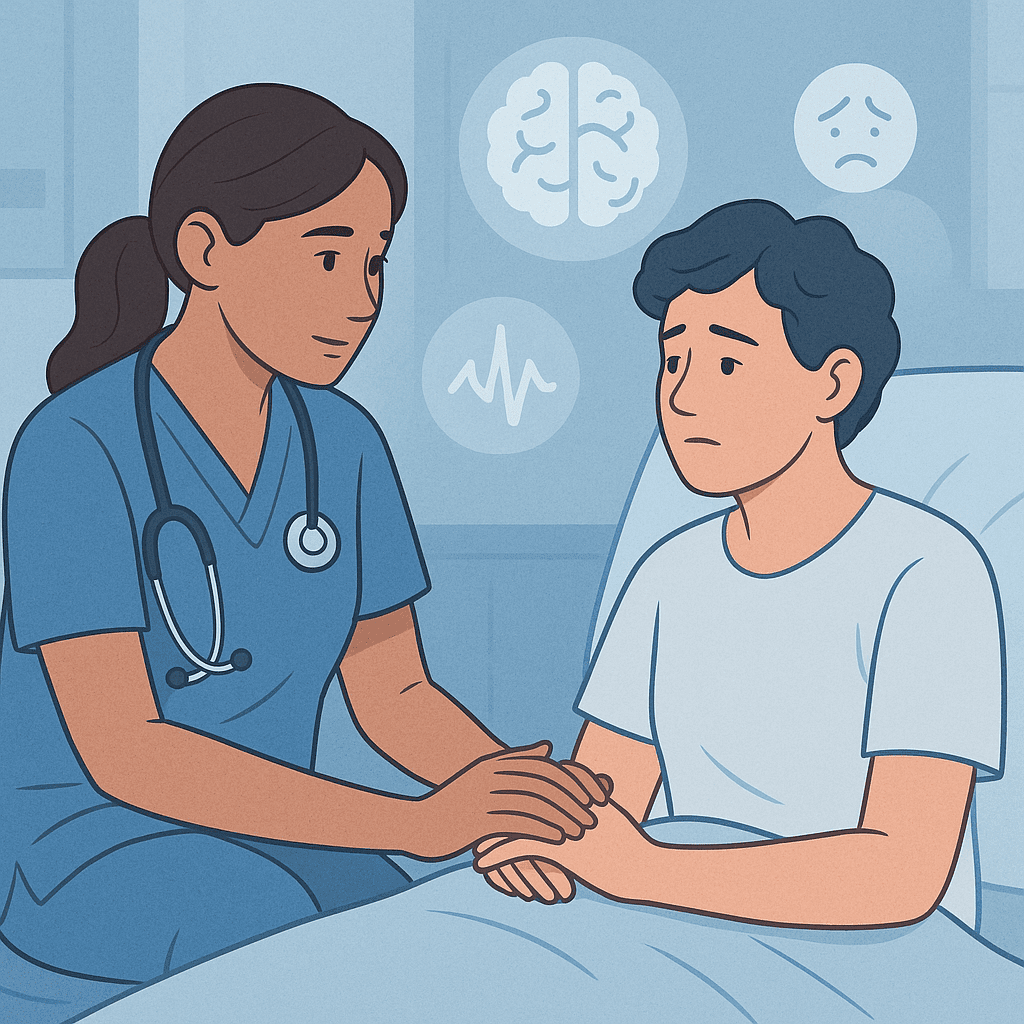Anxiety disorders are among the most common mental health conditions nurses encounter in practice. Understanding how to recognize and respond to Generalized Anxiety Disorder (GAD), Panic Disorder, and Phobias is essential for every registered nurse and RN nurse—both in clinical care and on the NCLEX.
This simplified guide breaks down the key features, nursing interventions, and patient teaching tips to help every nurse feel confident managing anxiety disorders.
🌿 What Is Anxiety?
Anxiety is a natural stress response—but when it becomes excessive and interferes with daily life, it turns into a disorder. For the nurse, distinguishing between normal worry and clinical anxiety is crucial.
In nursing practice, anxiety disorders often show up with both psychological and physical symptoms, such as:
- Restlessness or irritability
- Muscle tension
- Difficulty concentrating
- Sleep problems
- Palpitations or shortness of breath
Understanding these symptoms helps RN nurses assess patients more accurately and develop effective nursing care plans.
💭 1. Generalized Anxiety Disorder (GAD)
Definition:
GAD is persistent, uncontrollable worry about everyday events or situations that lasts for at least six months.
Common Symptoms:
- Constant worry
- Muscle tension and fatigue
- Difficulty concentrating
- Sleep disturbances
Nursing Interventions:
- Encourage relaxation techniques (deep breathing, mindfulness).
- Promote a calm environment to reduce triggers.
- Encourage expression of feelings.
- Administer anti-anxiety medications as prescribed (e.g., SSRIs, buspirone).
- Educate about avoiding caffeine and alcohol.
NCLEX Tip:
When a patient with GAD expresses worry, the best nursing response is therapeutic communication—acknowledge the patient’s feelings and avoid false reassurance.
⚡ 2. Panic Disorder
Definition:
Panic disorder involves sudden, unexpected episodes of intense fear known as panic attacks. These attacks can occur without warning and cause severe physical symptoms.
Symptoms:
- Chest pain, palpitations
- Shortness of breath or choking sensation
- Dizziness or fainting
- Fear of dying or losing control
Nursing Interventions:
- Stay with the patient during a panic attack.
- Use calm, reassuring communication.
- Teach the patient to use slow, deep breathing techniques.
- Educate about triggers (stress, caffeine, certain medications).
- After the attack, discuss coping strategies—not during the episode.
Registered Nurse Tip:
Avoid leaving a patient alone during a panic attack. The RN nurse’s presence provides emotional grounding and safety.
🕊️ 3. Phobias
Definition:
A phobia is an intense, irrational fear of a specific object, situation, or activity. Common examples include fear of heights (acrophobia), spiders (arachnophobia), or enclosed spaces (claustrophobia).
Symptoms:
- Immediate anxiety upon exposure to the feared object
- Avoidance behavior
- Physical symptoms like sweating, rapid heartbeat, or trembling
Nursing Interventions:
- Encourage gradual desensitization (controlled exposure to the fear).
- Use therapeutic communication to validate the patient’s fear.
- Support behavioral therapy and medications if prescribed.
- Educate the family about the importance of empathy and patience.
NCLEX Tip:
On the NCLEX, avoid encouraging patients to “just face their fears.” Instead, support gradual exposure therapy led by a mental health professional.
🩺 Nursing Assessment and Priorities
When caring for a patient with anxiety, a registered nurse should focus on:
- Assessing physical symptoms (rule out medical causes).
- Evaluating emotional state and level of anxiety.
- Monitoring medication side effects.
- Providing emotional support and patient education.
Priority Nursing Diagnosis:
- Anxiety related to perceived threat or stressor.
- Ineffective coping.
- Sleep pattern disturbance.
RN Nurse Action Plan:
Create a nursing care plan that includes emotional support, patient education, and ongoing evaluation of anxiety levels.
💡 Nursing Bundle Study Tip
If you’re preparing for the NCLEX, include Mental Health Nursing topics in your nursing bundle. These study materials help you master disorders like GAD, Panic Disorder, and Phobias with simplified visuals, therapeutic communication examples, and NCLEX-style questions.
Remember: the registered nurse doesn’t just treat anxiety—they guide patients through it with compassion and education.
🧩 Key Takeaways
✅ GAD = Constant worry about daily life
✅ Panic Disorder = Sudden, intense fear episodes
✅ Phobias = Irrational fear of a specific object or situation
✅ Best Nursing Intervention = Stay calm, use empathy, and support coping strategies
✅ NCLEX Focus = Therapeutic communication, safety, and patient education
🩹 Final Thoughts
For every RN nurse, understanding anxiety disorders is more than an exam topic—it’s part of providing compassionate care. Whether you’re helping a patient through a panic attack or teaching relaxation techniques for GAD, your nursing skills can make a real difference.
Add this topic to your nursing bundle and review it regularly—it’s a favorite on the NCLEX and essential for every registered nurse in clinical practice.
🩺 FAQs: Anxiety Disorders Simplified for Nurses
For the NCLEX, it’s essential to remember that Generalized Anxiety Disorder (GAD) involves persistent, excessive worry about daily events. Panic disorder is marked by sudden episodes of intense fear (panic attacks) with physical symptoms like palpitations or shortness of breath. Phobias are irrational fears triggered by specific objects or situations.
Every RN nurse should identify triggers and use therapeutic communication to reduce anxiety in patients.
In nursing practice, the top priorities include maintaining a calm environment, using active listening, and encouraging expression of feelings. Registered nurses should also teach relaxation techniques and monitor for medication side effects. For NCLEX questions, remember: safety and reassurance always come first.
Nurses should avoid giving false reassurance or dismissing feelings. Instead, use phrases like:
“Tell me more about what you’re feeling.”
“You’re safe here. I’m here to help.”
“Let’s try taking a few deep breaths together.”
The registered nurse’s first step is to stay with the patient, ensure a quiet environment, and use a calm voice. Avoid touching them until they’re calm. Once the panic subsides, help them identify triggers.
On the NCLEX, safety and reassurance are always the highest priorities in panic attack questions.

